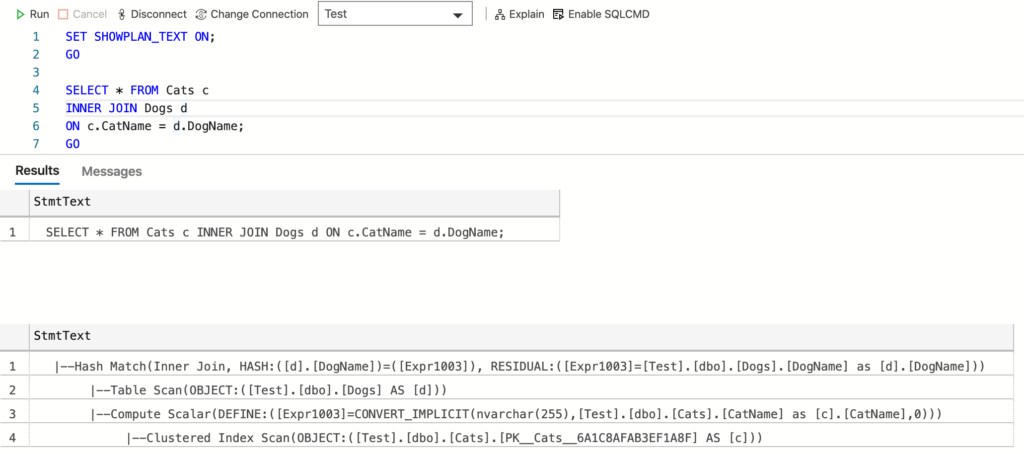In SQL Server, you can use the SET SHOWPLAN_TEXT statement to return detailed information about how a T-SQL statement is executed.
SHOWPLAN_TEXT returns information as a set of rows that form a hierarchical tree representing the steps taken by the SQL Server query processor as it executes each statement.
It’s similar to SHOWPLAN_ALL, except that it returns less details. It’s therefore aimed towards applications that can’t handle the extra details that SHOWPLAN_ALL provides.
You can set SHOWPLAN_TEXT to either ON or OFF.
When SHOWPLAN_TEXT is ON, all subsequent T-SQL statements are not executed. Instead SQL Server returns execution information for the statement (without executing it).
Example
Here’s an example to demonstrate.
SET SHOWPLAN_TEXT ON;
GO
SELECT * FROM Cats c
INNER JOIN Dogs d
ON c.CatName = d.DogName;
GONote that SET SHOWPLAN_TEXT cannot be specified inside a stored procedure, and it must be the only statement in a batch.
Here’s what the result looks like in Azure Data Studio:

And here’s what it looks like in mssql-cli (command line interface):
Commands completed successfully. +------------+ | StmtText | |------------| | SELECT * FROM Cats c INNER JOIN Dogs d ON c.CatName = d.DogName; | +------------+ (1 row affected) +--------------------------------------------------------------------------------------------------------------------------------------+ | StmtText | |--------------------------------------------------------------------------------------------------------------------------------------| | |--Hash Match(Inner Join, HASH:([d].[DogName])=([Expr1003]), RESIDUAL:([Expr1003]=[Test].[dbo].[Dogs].[DogName] as [d].[DogName])) | | |--Table Scan(OBJECT:([Test].[dbo].[Dogs] AS [d])) | | |--Compute Scalar(DEFINE:([Expr1003]=CONVERT_IMPLICIT(nvarchar(255),[Test].[dbo].[Cats].[CatName] as [c].[CatName],0))) | | |--Clustered Index Scan(OBJECT:([Test].[dbo].[Cats].[PK__Cats__6A1C8AFAB3EF1A8F] AS [c])) | +--------------------------------------------------------------------------------------------------------------------------------------+ (4 rows affected) Commands completed successfully.
How to Turn it Off
You can turn it off by using SET SHOWPLAN_TEXT OFF.
Once you’ve done this, subsequent statements will execute as normal.
SET SHOWPLAN_TEXT OFF;
GO
SELECT * FROM Cats c
INNER JOIN Dogs d
ON c.CatName = d.DogName;
GOResult:
Commands completed successfully. +---------+-----------+---------+-----------+-----------+ | CatId | CatName | DogId | DogName | GoodDog | |---------+-----------+---------+-----------+-----------| | 2 | Fluffy | 2 | Fluffy | 0 | +---------+-----------+---------+-----------+-----------+ (1 row affected) Commands completed successfully.
Deprecated or Not?
According to this old MSDN article, SET SHOWPLAN_TEXT is scheduled for deprecation in future showplan versions, and it is recommended that you use SET SHOWPLAN_XML instead.
However, that MSDN article is for SQL Server 2008 R2, and as I write this, it doesn’t seem to have been deprecated in SQL Server 2019. In fact, the current documentation makes no mention of deprecation, and it isn’t included when I run a list of deprecated items in SQL Server.
Either way, it probably pays to bear this in mind before using it in future releases.
Graphical Execution Plan
If you’re using a graphical tool such as SSMS or Azure Data Studio, you might have the option to view the estimated graphical query execution plan for the current query.
- In SSMS you can use Ctrl + L to do this. Or you can click the Display Estimated Execution Plan icon, or right-click in the query window and select Display Estimated Execution Plan.
- In Azure Data Studio, you can click the Explain button above the query window.
You can also use SET SHOWPLAN_XML ON to enable it, and SET SHOWPLAN_XML OFF to disable it.